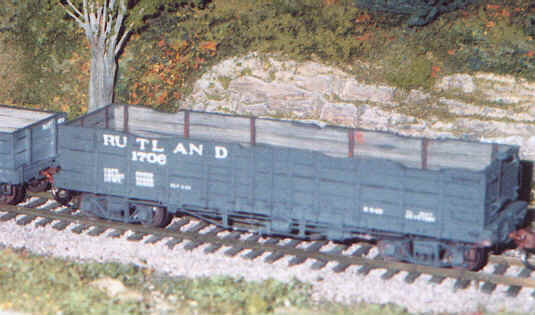Remembering the Rutland - Modeling the Rutland
Interior Detailing of Rutland Gondolas
by Don Janes
 |
Model and photo by Don Janes |
After completing models of Funaro and Camerlengo Rutland gondolas in the 4100 and 1700 series I found that they just didn’t look complete after weathering the cars. The interiors still looked unused. To give a more "used" look I decided to line the cars with 1" x 12" scale lumber. The strips were first given a treatment of India ink/ rubbing alcohol wash. After this I distressed the wood with an Exacto #11 blade (preferably used). To give an even more aged look I applied a wash of Floquil Driftwood and let this dry. Finally, a thin wash of Floquil Grimy Black was applied to all the strips.
Once dry, I precut all the pieces I needed to line each car and started gluing them in place with diluted contact cement (dilute with lacquer thinner). Start from the bottom and work up. As I came to distressed areas on the car sides I duplicated these spots by carving out bits of wood to match the cast-on boards. Once the cars were fully lined with individual boards I added the resin strips that represent the iron bars used to hold the boards in place. These were given a coat of rust using paint and chalk.
One other detail that helps the aging process of the cars is to add 8- or 10-inch scribed siding to the car floors to give a more individual board look. This is finished in the same manner as the sideboards. I only used this method on the 4100 series car since the 1700’s have excellent cast in detail in the floors.
This added detail is very easy to do and requires very little time but really adds to the overall aged look of the cars.
Footnote: Remarks by Bill Badger
Everyone who has a copy of Robert Willoughby Jones' Boston and Maine, Forest, River and Mountain can look on page 103 and see that effect on what looks like one of the Rutland 4000 gondolas. What I noticed immediately in the photo was the light gray interior in contrast with the black exterior. Probably the combination of marble dust and the natural weathering of the wood combined to give a lighter gray than one would expect from general service. Cars in on-line coal service would probably have had darker interiors due to the coal dust. I wonder if there was any effort (or reason) to have kept cars in coal service separate from those hauling scrap marble?